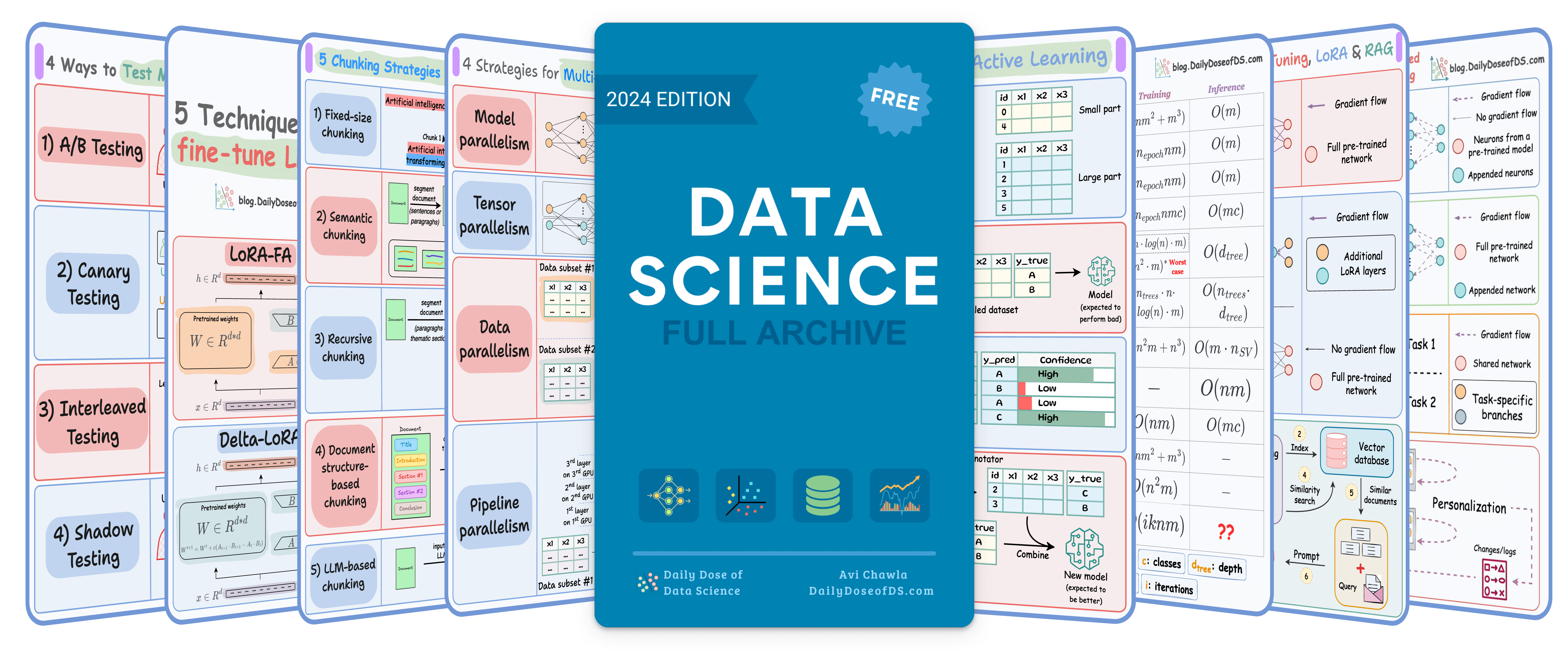

TODAY'S ISSUE
Open-source Agent Development Framework
Build production-grade Agents with CoAgents [Open-source]
Building agent-native apps is challenging, and a lot of it boils down to not having appropriate tooling.
But this is changing!
CoAgents, an open-source framework by CopilotKit, lets you build Agents with human-in-the-loop workflows: CopilotKit GitHub Repo (star the repo).
The latest updates to CoAgents bring together:
- LangGraph JS to build modular, debuggable workflow creation.
- LangGraph Platform to ensure production-grade reliability.
- LangSmith to monitor, debug, and visualise the agent.
Moreover, CoAgents also lets you:
- Steer Agent to correct things.
- Stream the intermediate agent states.
- Share the state between the agent & the app.
- Use Agentic UI to generate custom UI components.
Impressive, right?
Big thanks to CopilotKit for partnering today and showing what's possible with their powerful Agent-development framework.
TODAY’S DAILY DOSE OF DATA SCIENCE
LoRA/QLoRA—Explained from a business lens
Consider the size difference between BERT-large and GPT-3:
I have fine-tuned BERT-large several times on a single GPU using traditional fine-tuning:

But this is impossible with GPT-3, which has 175B parameters. That's 350GB of memory just to store model weights under float16 precision.
This means that if OpenAI used traditional fine-tuning within its fine-tuning API, it would have to maintain one model copy per user:
- If 10 users fine-tuned GPT-3 → they need 3500 GB to store model weights.
- If 1000 users fine-tuned GPT-3 → they need 350k GB to store model weights.
- If 100k users fine-tuned GPT-3 → they need 35 million GB to store model weights.
And the problems don't end there:
- OpenAI bills solely based on usage. What if someone fine-tunes the model for fun or learning purposes but never uses it?
- Since a request can come anytime, should they always keep the fine-tuned model loaded in memory? Wouldn't that waste resources since several models may never be used?
LoRA (+ QLoRA and other variants) neatly solved this critical business problem.
The core idea revolves around training a few parameters compared to the base model.
For instance, if the original model has a weight matrix W (shape d*d), one can define the corresponding LoRA matrices A (d*r) and B (r*d).
↳ where r<<<<d (typically, r is a single-digit number).
During fine-tuning, freeze the weight matrix W and update the weights of the LoRA matrices.
During inference, the product of the LoRA matrices results in a matrix of the same shape as W. So one can obtain the output as follows:
This way, every user gets their LoRA matrices, and OpenAI can maintain just one global/common model.
Another good thing is that LoRA matrices usually do not require more than 20-25 MB of memory per user. This is immensely smaller than what we get from traditional fine-tuning.
Lastly, this also solves the other two problems we mentioned earlier:
- If someone fine-tunes the model just for fun or learning purposes but never uses it, it's okay; LoRA matrices are still manageable.
- Loading small LoRA matrices from disk isn't tedious either. These small matrices can be off-loaded if not used for a while and reloaded when needed.
We implemented LoRA for fine-tuning LLMs from scratch here →
LoRA has several efficient variants. We covered them here →
Moreover, if you want to develop expertise in “business ML,” we have discussed several other topics (with implementations) that align with it:
Here are some of them:
- A Crash Course on Graph Neural Networks – Part 1.
- Quantization: Optimize ML Models to Run Them on Tiny Hardware.
- Conformal Predictions: Build Confidence in Your Model's Predictions.
- A Practical Guide to Scaling ML Model Training.
- 5 Ways to Test ML Models in Production (Implementation Included)
- Federated Learning: Build Privacy-Preserving ML Models.
- Model Compression: A Step Towards Efficient Machine Learning.
Why care?
All businesses care about impact. That’s it!
- Can you reduce costs?
- Drive revenue?
- Can you scale ML models?
- Predict trends before they happen?

Thus, the ability to make decisions, guide strategy, and build solutions that solve real business problems and have a business impact will separate practitioners from experts.
👉 Over to you: What are some other benefits of LoRA over traditional fine-tuning?
THAT'S A WRAP
No-Fluff Industry ML resources to
Succeed in DS/ML roles

At the end of the day, all businesses care about impact. That’s it!
- Can you reduce costs?
- Drive revenue?
- Can you scale ML models?
- Predict trends before they happen?
We have discussed several other topics (with implementations) in the past that align with such topics.
Here are some of them:
- Learn sophisticated graph architectures and how to train them on graph data in this crash course.
- So many real-world NLP systems rely on pairwise context scoring. Learn scalable approaches here.
- Run large models on small devices using Quantization techniques.
- Learn how to generate prediction intervals or sets with strong statistical guarantees for increasing trust using Conformal Predictions.
- Learn how to identify causal relationships and answer business questions using causal inference in this crash course.
- Learn how to scale and implement ML model training in this practical guide.
- Learn 5 techniques with implementation to reliably test ML models in production.
- Learn how to build and implement privacy-first ML systems using Federated Learning.
- Learn 6 techniques with implementation to compress ML models.
All these resources will help you cultivate key skills that businesses and companies care about the most.
SPONSOR US
Advertise to 600k+ data professionals
Our newsletter puts your products and services directly in front of an audience that matters — thousands of leaders, senior data scientists, machine learning engineers, data analysts, etc., around the world.





